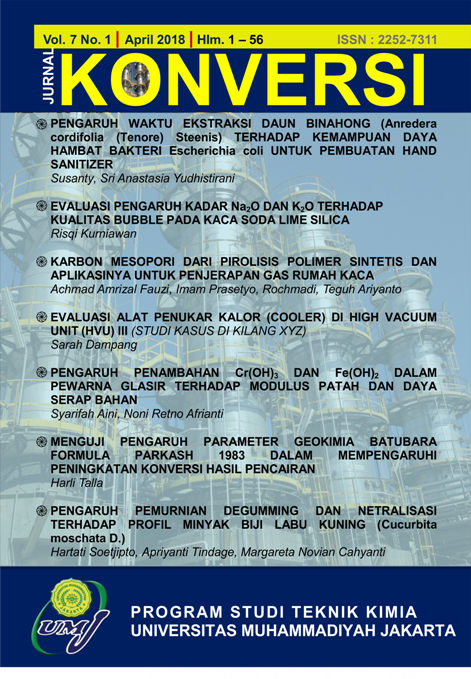PENGARUH PENAMBAHAN Cr(OH)3 DAN Fe(OH)2 DALAM PEWARNA GLASIR TERHADAP MODULUS PATAH DAN DAYA SERAP BAHAN
Main Article Content
Abstract
Heavy metal waste is B3 waste that has hazardous and environmentally damaging effect, such as electroplating industry waste which produces Cr(OH)3 and Fe(OH)2 wastes. The purpose of this research is to use the waste as a mixture of glaze and to know how much the effect of Cr(OH)3 and Fe(OH)2 addition in glaze dye to the fracture modulus and the absorption capacity of the material. The materials were mashed and sieved with a size of 200 mesh, then the three materials were mixed with homogeneous which have 15% leucite, 15% lime, 70% borax composition, then suspended with water until homogeneous. Afterward, added Fe(OH)2 (comparison mix of dye as much as 3%-7% weight of glaze). The experiment was repeated by adding Cr(OH)3, then a mixture of Fe(OH)2 and Cr(OH)3. The suspension result is poured onto the test tile and be spread evenly, then inserted into the muffle, heated to 900oC for 2 hours and cooled. After that, analyzed the fracture modulus and absorption capacity of the test tile. The result of this study; first, the addition of 6% Fe(OH)2 optimize the brown color. Second, the addition of 7% Cr(OH)3 optimize the green color. Last, the addition of 3% mixture of Fe(OH)2 and Cr(OH)3 optimize yellowish green color. From the research data it can be concluded that the more metal oxides are added, the greater the fracture modulus, and the smaller the absorption.
Article Details
Issue
Section
Articles
Authors who publish with this journal agree to the following terms:
- Authors retain copyright and grant the journal right of first publication with the work simultaneously licensed under a Creative Commons Attribution License that allows others to share the work with an acknowledgement of the work's authorship and initial publication in this journal.
- Authors are able to enter into separate, additional contractual arrangements for the non-exclusive distribution of the journal's published version of the work (e.g., post it to an institutional repository or publish it in a book), with an acknowledgement of its initial publication in this journal.
- Authors are permitted and encouraged to post their work online (e.g., in institutional repositories or on their website) prior to and during the submission process, as it can lead to productive exchanges, as well as earlier and greater citation of published work (See The Effect of Open Access).
